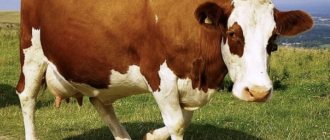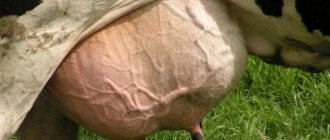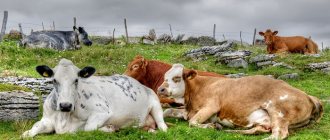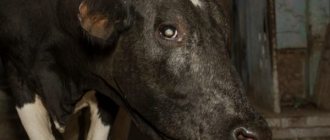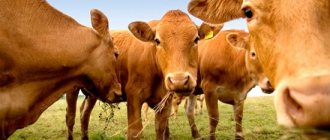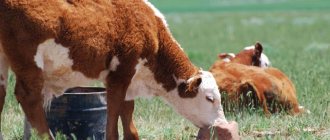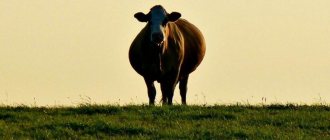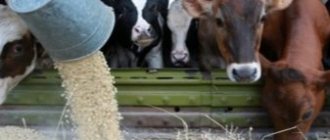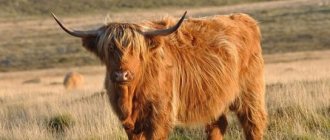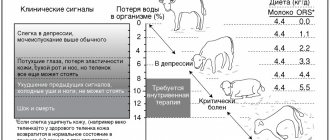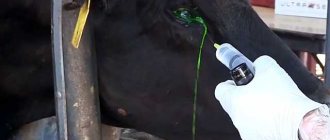Calving is a complex physiological process that occurs in the cow’s body under the influence of many reasons with the expulsion of the fetus, placenta and amniotic fluid.
The birth of calves is an important event in the life of a livestock breeder. At the same time, it is important that everything goes well and they are healthy. In order to achieve this, it is necessary to prepare for the calving of cattle in advance and provide the necessary conditions.
When the time of birth approaches, animals must be treated with special care. If there are changes in the cow's behavior, you need to take a closer look at her.
The key role belongs to neurohumoral regulation carried out by the mother-fetus complex. Under the influence of corticoid hormones secreted by the calf, prostaglandins begin to be secreted in the placenta, inhibiting the functions of the corpus luteum and progesterone.
This enhances the contractile function of the uterus and initiates the onset of contractions.
Childbirth in cows is a responsible process, especially in highly productive animals and first-calf heifers. The narrowness of the pelvis, the large size of the calves and the unpreparedness of the cow often lead to fetal death and postpartum complications.
Therefore, it is necessary to properly prepare cattle for calving and organize qualified assistance.
Preparing a cow for birth
A cow's pregnancy lasts a long time, approximately 283 days. During this time, you need to have time to prepare yourself, and help your cow in this. First of all, you need to provide her with constant attention, and also mark the upcoming calving date on the calendar. When the time comes, the animal will most likely show this through its behavior. The cow may look restlessly around her belly, lie down and get up again, and even run into the field to hide.
Usually, the calving process in cows occurs without complications, but it is still better to show her to the veterinarian in advance. He will be able to mark the date of birth most accurately, and also tell whether there are any pathologies.
In addition, you should make special preparations for the appearance of a calf: clean up the room, transfer the pet to a special diet and follow some other rules.
And we will tell you how to do this further. When it becomes clear that a cow is about to give birth, preliminary preparations need to be made.
It is necessary for the woman in labor to provide rest for several days before this event. To do this, the farmer must gradually reduce the number of milkings. When this happens only once every day, you will need to move on to milking the cow every other day. Then, after five or six days have passed, and the amount of milk received has reached 500 ml, it will be necessary to stop milking completely.
The second important issue that needs to be resolved at this time is the amount of feed that the animal will consume. The fact is that during this period cows have a strong tendency to obesity. To prevent this, it is necessary to carefully control the amount of feed given to the animal.
Preparing the cow for calving.
One of the most important conditions for obtaining high milk yields and a strong, viable calf is proper preparation of the cow for calving.
A cow cannot be milked from calving to calving. 2 months, and the first heifer and highly productive cow 65-70 days before calving must be transferred to dry land. During the dry period (start-up), the cow’s body rests and replenishes its supply of nutrients and minerals. A well-rested cow during the dry period will produce a healthy, strong calf and will produce greater milk yield in the next lactation.
Calving calendar for cows - a table of expected starts and calving for cows is carried out gradually over several days, depending on the productivity of the cow. Often, in order to get a good offspring and high milk yield after the expected calving, a cow has to be started even with a daily milk yield of 10-15 kilograms. First of all, silage, root vegetables and other succulent feeds, as well as concentrates, are excluded from the feed ration. At the same time, the water supply is reduced and the number of milkings is reduced. By the time of final start-up, a dry cow should only be fed hay. During the launch period, you should not massage the udder.
When starting in the summer, the cow is deprived of feeding with green grass and concentrated feed (grain fodder, bran, compound feed, etc.). In addition, the duration of keeping it on pasture is gradually reduced. As a last resort, to speed up the start, the cow is switched to feeding with hay.
5-6 days after milking stops, when the udder decreases in volume (“dries out”), the cow must be gradually prepared for calving.
By the time of calving, the cow should have good nutrition and be in good body condition. Feeding during the dry period should ensure an increase in its live weight by approximately 50-75 kilograms. However, you should not overfeed a cow: this can have a detrimental effect on her health.
A pregnant cow should be given only good quality feed: good hay, turnips, fodder or sugar beets, silage.
Depending on the live weight and productivity, bran, corn dirt and other concentrated feeds available on the farm must be added to the daily feed of a pregnant cow.
The daily feed must fully meet the need of a pregnant cow for nutrients and minerals, as well as vitamins. A good source of vitamins are: good quality hay and silage in winter, pasture grass in summer.
In the winter (stall) period, the daily ration of a pregnant cow weighing 400 kilograms should consist of approximately 812 kilograms of good quality hay, 12-16 kilograms of succulent feed (turnips, fodder beets, potatoes, etc.) and 1.5-2 kilograms concentrated feed. In addition, it is necessary to give table salt and chalk daily.
A pregnant cow is fed three times a day, at the same hours. Give fresh, clean, not very cold water at least three times a day. The cow must be watered before distributing concentrates. You cannot give water from stagnant ponds and swamps, as this can have a harmful effect on the health of the cow and her future offspring.
In summer, a pregnant cow must be kept on pasture. Pasture grass is the most complete food for a pregnant cow, as it contains all the nutrients, minerals and vitamins. If there is a lack of pasture feed, the cow is fed with freshly cut grass.
A pregnant cow needs good housing conditions and especially careful care. The room in which it is kept must be bright, dry, and free from drafts. The floor in such a room should be smooth and non-slippery. The cow must be provided with dry bedding for the entire period of pregnancy. Keeping a cow on a cold, damp floor and without bedding can cause colds and even inflammation of the udder.
In winter, if there is no ice, a pregnant cow should be allowed out for a walk for 2-4 hours, depending on the weather. Walking strengthens the body, maintains normal bowel function and ensures healthy growth. Walking is stopped only 2-3 days before calving.
A pregnant cow should be cleaned daily with a straw rope and then with a brush, and contaminated areas should be washed with warm water and wiped dry with a dry, clean cloth.
In a cow, a normal pregnancy lasts approximately 285 days. In order not to miss calving time, you must be guided by the calving calendar of cows.
| Cow calving calendar - table of expected launch and calving of cows | |||
| mating time | calving time | ||
| month | number | month | number |
| January | 1 | October | 12 |
| January | 11 | October | 22 |
| January | 21 | November | 1 |
| January | 31 | November | 11 |
| February | 10 | November | 21 |
| February | 20 | December | 1 |
| March | 2 | December | 11 |
| March | 12 | December | 21 |
| March | 22 | December | 31 |
| April | 1 | January | 10 |
| April | 11 | January | 20 |
| April | 21 | January | 30 |
| May | 1 | February | 9 |
| May | 11 | February | 19 |
| May | 21 | March | 1 |
| May | 31 | March | 11 |
| June | 10 | March | 21 |
| June | 20 | March | 31 |
| June | 30 | April | 10 |
| July | 5 | April | 15 |
| July | 15 | April | 25 |
| July | 25 | May | 5 |
| August | 4 | May | 15 |
| August | 14 | May | 25 |
| August | 24 | June | 4 |
| September | 3 | June | 14 |
| September | 13 | June | 24 |
| September | 23 | July | 4 |
| October | 3 | July | 14 |
| October | 13 | July | 24 |
| October | 23 | August | 3 |
| November | 2 | August | 13 |
| November | 12 | August | 23 |
| November | 22 | September | 2 |
| December | 2 | September | 12 |
| December | 12 | September | 22 |
| December | 22 | October | 2 |
| January | 1 | October | 12 |
Preparing the premises
The facility is prepared for calving to minimize potential infections to the calf. The floor, walls and all equipment, including feeders, are disinfected using caustic soda solution (2%) or creolin solution (2%).
The bedding is usually changed to fresh one a little in advance so that it warms up and smells like a cow. The best bedding is straw, but it is better to avoid sawdust in the room where the pregnant animal is located.
The following video shows how to help a cow with weak attempts - useful material for those who are faced with weak contractions in an animal.
How to prepare for childbirth?
First of all, the animal must be under constant supervision. When a cow gives birth, she begins to behave differently than always: she worries, changes her body position, and can even run into the field to hide from everyone. If you already understand that labor is about to begin, you need to wash the udder and back, including the vestibule of the vulva. For these purposes, a solution of potassium permanganate is used. Obstetric care from a veterinarian is usually not required; a doctor is called only if the birth occurs with complications.
Healthy animals usually cope on their own, but it just so happens that a person is present when the calf is about to be born. This doesn’t happen every day and it wouldn’t hurt to be proactive in this matter. Most often, childbirth takes place standing, less often - in a lying position. Next, we will look at how to prepare for the birth of a baby and what actions need to be taken before calving itself.
Preparing the premises
The facility is prepared for calving to minimize potential infections to the calf. The floor, walls and all equipment, including feeders, are disinfected using caustic soda solution (2%) or creolin solution (2%). The bedding is usually changed to fresh one a little in advance so that it warms up and smells like a cow. The best bedding is straw, but it is better to avoid sawdust in the room where the pregnant animal is located. The following video shows how to help a cow with weak attempts - useful material for those who are faced with weak contractions in an animal.
Special diet
A week before giving birth, the cow begins to be given bean or cereal hay, and concentrates are reduced to a kilogram per day or removed completely. There is an opinion that succulent feed is harmful before calving. This belief is explained by the increasing likelihood of edema and abortion. Hay and silage diets are the most favorable for the expectant cow mother. Food, unfortunately, does not help against udder swelling, but regular long walks do.
Signs of approaching labor
If the birth is close, this can be perfectly understood.
- The first sign is maturation, that is, the beginning of lactation. Milk appears in the udder, this happens at least a day before the calf is born, or even 2 weeks. If the udder nipples begin to stick out, this is a sure sign that everything is about to begin.
- The second sign is swelling of the vulva. It softens, forms folds and is clearly visible to the eye.
- The third sign is drooping of the tail.
- The fourth indicator is the animal’s nervousness, attempts to kick its own belly. It is unpleasant for the cow, since the process of contractions is painful in itself. She moos and changes her body position, hides in a secluded place in the barn or goes to the corner of the pen.
- The fifth sign is a clear discharge from the vulva. This is mucus from the cervix and vagina that makes it easier for the calf to pass.
- The last signs: drooping sides (which means the fetus was moving towards the exit) and the discharge of amniotic fluid. The fertilizing sac or sac comes off in front of the baby.
The following video will help you more fully imagine the birth process.
Weekly readiness
A week before calving, the cows carefully prepare the place where the expectant mother and her calf will live. It is advisable to start preparations earlier in order to avoid surprises associated with premature birth. Even if the stall is empty, periodically re-straw the straw in it. It should be large enough to accommodate both mother and calf comfortably.
During this period, special attention is paid to feeding the pregnant cow. The diet should be balanced. To understand how correctly you are feeding your animal during pregnancy, you need to systematically weigh it. At the time of calving, the cow should gain, on average, 65 kg.
Signs of approaching calving
Of course, you can find out about the approximate calving time of a cow by calculating the period of her pregnancy (for cows it is 270-300 days). The last two weeks before the approximate due date, the cow must be closely monitored. The approach of calving can be judged by a number of signs:
2-3 weeks before calving, the udder noticeably enlarges and the belly stretches down.
5-10 days before calving, the ligaments in the pelvis and root of the tail relax, become soft, the external genitalia swell, and a secretion resembling sugar syrup is milked from the udder. The closer the birth is, the more this secretion resembles milk - it becomes whiter and “milky”.
1-2 weeks before calving, the cow’s udder noticeably enlarges, the pelvic ligaments relax, which is noticeable by the indentations on the side of the tail root, and the vulva swells.
12-20 hours before calving, colostrum flows to the udder nipples, and clear mucus is released from the vagina. The cow shows signs of anxiety and becomes fearful.
Caring for cows after calving
After calving, the cow is given fresh, high-quality hay and warm water. The next day they begin to give feed concentrates, and from the 5th day they feed with green or succulent feed, gradually forming the diet according to milk yield. The swollen udder is massaged, and in order for the swelling to disappear quickly, the animal is often milked (up to 6 times a day).
If calving has passed without complications, on the 2-3rd day the cow can be released for a walk. The room where the calf lives with its mother is constantly cleaned, since the cow has postpartum discharge. The remains of the placenta, placenta and fetal membranes are usually passed as a reddish mass immediately after calving or within 12 hours.
Harbingers of childbirth
Relaxation of the pelvic ligaments occurs 12-36 hours before the onset of the fetus. Rarely, but there are exceptions when the ligaments begin to relax immediately before childbirth, or 2 weeks before its onset. Still, in more rare cases, the ligaments relax, and then, after some time, become tight again.
In a normal cow, when pressing on the area of the subcaudal ligament, a dense and immobile cord (ligament) is felt. When palpating this ligament in a pregnant cow, within the period specified before birth, the cord will be relaxed and pliable. Taking it with your fingers, you can easily move it in any direction.
With strong relaxation, the contours of this ligament are smoothed out to such an extent that it becomes difficult to palpate at all.
Another very clear harbinger of childbirth is the enlargement and swelling of the labia - their skin loses folds and becomes smooth.
Diseases that occur after childbirth
Postpartum complications also include confinement, paresis (the hindquarters become heavy and the animal cannot stand up), mastitis and lack of milk (cessation of lactation) or decreased milk production. You should not self-medicate, as this can lead to serious consequences. Sometimes the reason for lack of lactation is an incorrectly formulated diet. Also, most postpartum complications can be caused by the fact that the cow does not walk much during pregnancy.
